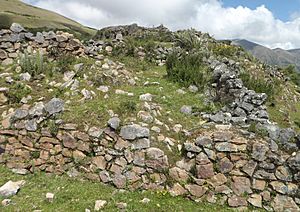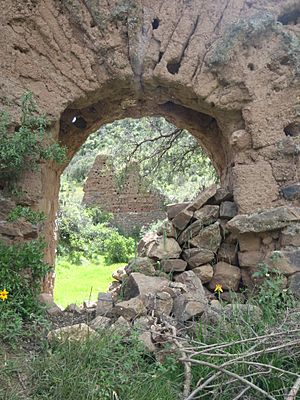Yanaca facts for kids

Ruins of a house in Tunay Q'asa village
|
|
| Location | Yanaca District, Aymaraes Province, Apurimac Region, Peru |
|---|---|
| Region | Andes |
| Type | Settlement |
Yanaca is a collection of ancient towns in Peru. These old settlements are found in the Apurimac Region, specifically in the Yanaca District. They are nestled in the Andes mountains, between two geographical areas known as Quechua and Suni. Today, the modern town of Yanaca is located near these historic sites.
Contents
Yanaca's Ancient History
Who Lived in Yanaca First?
It's tricky to know exactly when the first people arrived in Yanaca. More archaeological digs could help us learn more about the early Yana people. Experts believe the first settlers in the wider region came from Asia around 2,000 BCE. They likely settled in an area called Pacaicasa, according to historian José Rios Velazquez.
Before the powerful Incan civilization took over, many different groups lived in this region. These included the Quechuas, Pocras, Aucarunas, and Aymaras. Some historians think the Aymara language was spoken in the area before the Inca arrived. The Yana people were also present in this region.
How Did the Inca Empire Affect Yanaca?
According to old writings by Felipe Guaman Poma de Ayala, the Yana tribes willingly joined the Incan Empire between 1350 and 1400. They submitted to Incan leaders like Mayta Capac and his brother. They traveled along an ancient road that still exists today.
During the time of the Inca Empire, the Yanas seemed to have become part of the Incan society. Some historians, like Garcilaso, describe the Yanas as servants to the Inca. Others suggest they simply helped the Inca in various ways.
However, another historian, Miguel Cabello de Balboa, wrote that many Yana people faced harsh treatment from the Inca. One idea is that during the rule of Pachacutec, some Yana groups moved to towns farther from Cuzco, the Incan capital, to avoid conflict.
Some historians, like Murra and Garcilaso, believe the Yanas might have benefited from their position in Incan society. They took on important jobs at the noble court, such as carpentry, cooking, and cleaning. R. Tom Zuidema also agrees with this idea. His research suggests that Yanaca played a significant role in the Inca's social, political, and religious life.
The Inca Empire divided its land into different areas. The province of Aymaraes, where Yanaca is located, was split into four sub-provinces. Yanaca was one of these important sub-provinces.
What Happened When the Spanish Arrived?
After the Inca Empire fell, Francisco Pizarro ordered the distribution of indigenous people across the former Incan lands in 1540. The Spanish colonized Yanaca a few years later.
It's thought that the Spanish first settled in a town called Parangay, close to Yanaca. You can still see the ruins of the first church they built there. This church was made from stone and adobe. It stands between Parangay and the ruins of Chacha-calla, another ancient town in the Yanaca district.
Records from this time show that many people lived in the Yanaca valley. A count in 1572 recorded about 30,000 people.
In 1720, a Spanish official named Don Juan de Beytia arrived in Yanaca. He ordered that the scattered towns should become separate, independent communities. The modern town of Yanaca likely started forming in the late 1500s or early 1600s, even though the area was previously a group of smaller, spread-out settlements.
Ancient Farming Methods: Andenes
You might hear different stories about how the andenes (terraces) were built. But they were actually created by the people who lived here before the Inca. These terraces were used for farming, especially for growing maize (corn). People in Yanaca still use this clever farming method today!
Other Interesting Parts of Ancient Culture
Apus: Mountain Gods
In the ancient Andean religion, the Apus are powerful gods represented by mountains. In Yanaca, some of these important Apus are Tunay Kassa, Cóndor Carca, Solimana, and Sara Sara. Solimana and Sara Sara are seen as the main gods, creating all the other Apus in Yanaca. These mountain gods were believed to control things like rain, harvests, fertility, and even illnesses or accidents. People performed special ceremonies, like the "tinka" or "despacho," for the Apus, especially when it was time to plant crops. The Pacha Mama (Mother Earth) was also highly respected.
Condorccarcca: A Special Mountain
Condorccarcca is a mountain located northeast of Yanaca. It seems to have been a special place for ceremonies for the nearby towns. It might have even been used as an observatory! The shadows cast by the mountains could have helped people track the farming seasons, the longest and shortest days of the year (solstices), and when day and night are equal (equinoxes).
Learning More About Yanaca
Not many studies have been done in this part of Peru. However, Doctor Juan Ossio Acuña, who was Peru's Minister of Culture, studied the Yanaca people in 1996. He looked into their traditions and their history before the Inca. Doctor R. Tom Zuidema also studied the Inca and mentioned Yanaca, noting that a group called Rimacvillca was connected to these people.
See also
 In Spanish: Yanaca para niños
In Spanish: Yanaca para niños


